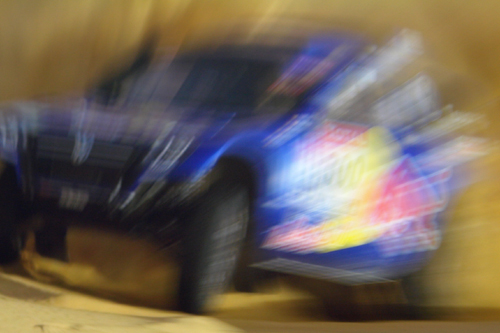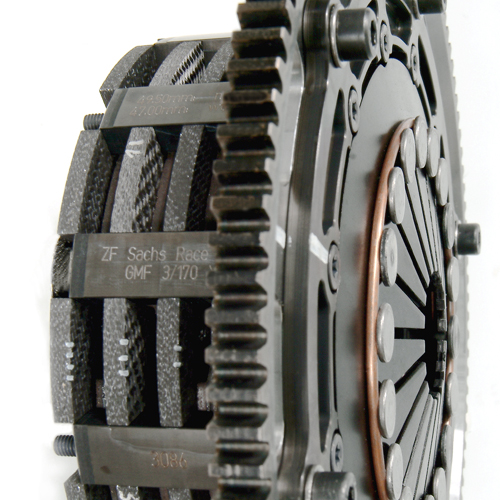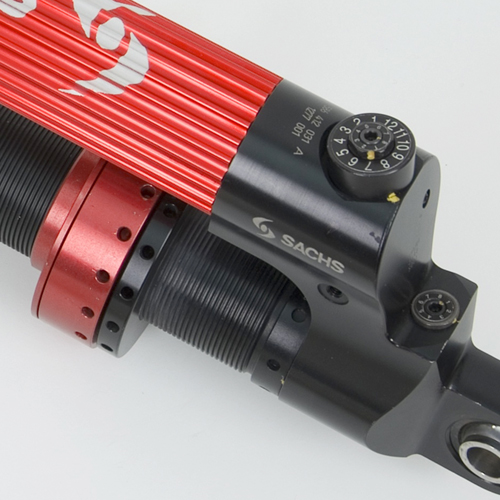
Can Volkswagen score a hat-trick with ZF Sachs in the Dakar Rally?
Schweinfurt, 29 December 2010 – Volkswagen tackles the 2011 Dakar Rally with four Race Touareg after the manufacturer scored its second consecutive Dakar Rally victory in January 2010 and its third victory overall in company history. ZF Sachs Race Engineering high-performance technology, which is used in the Race Touareg transmission and suspension since 2006, also remains an important component for success in the forthcoming Dakar Rally held between 1 and 15 January 2011. Leading teams in the truck category also rely on the German technology.
9,618 kilometres through South America, including 5,020 against the clock, crossing the Andes twice, stages in the world’s highest-altitude desert, tough tests on gravel, scree and bush tracks – everything is thrown at the competitors again in 2011 during the world’s toughest rally. The Race Touareg suspension, with a total of eight dampers, and the clutches installed in the TDI diesel powered off-road vehicle are subject to extremely high forces. Race trucks in the truck category must also master the route. The Russian manufacturer Kamaz, which relies on ZF technology, targets its tenth victory in this competition.
Volkswagen compete with four new Race Touareg 3 and the defending champions
With Giniel de Villiers/Dirk von Zitzewitz (ZA/D), the 2009 “Dakar” winners, and Carlos Sainz/Lucas Cruz (E/E), winners in 2010, the most recently triumphant Volkswagen crews confront the world’s toughest rally once again. As last year, the American-South African duo of Mark Miller/Ralph Pitchford and Nasser Al-Attiyah from Qatar with his German co-driver Timo Gottschalk start for Volkswagen. The German automobile concern relies on the newly developed Race Touareg in the Dakar Rally for the first time.
Kamaz aims to extend its record in the truck category to ten victories
Kamaz already holds a record in the truck class recording nine wins since 1996; however, the Russian team aims to win again with ZF and ZF Sachs technology. Last year’s winner Vladimir Chagin shares his truck this time with fellow Russians Sergey Savostin and Ildar Shaysultanov. Firdaus Kabirov/Aydar Belyaev/Andrey Mokeev and Eduard Nikolaev/Viatcheslav Mizyukaev/Vladimir Rybakov also compete in the commercial vehicles from the Republic of Tatarstan. Ilgizar Mardeev/Vladimir Demyanenko/Ayrat Mardeev, the trio Sergey Reshetnikov/Andrey Rudnitskiy/Marius Adamek and Artur Ardavichus/Denis Berezovskiy/Zhanat Zhalimbetov start in three more Kamaz race trucks.
Impressive service life of ZF Sachs products in Race Touareg
The stresses and strains are enormous: In contrast to the majority of circuit race cars, a vehicle competing in the Dakar Rally is by no means subject to regular conditions when running. Sections through fine sand, climbing along trial tracks, high-speed segments, extreme rolling-resistance in thick mud – all this exerts significant loads on every mechanical component in the Race Touareg 3. In the middle of all this: the clutch which must always reliably transmit 228 kW (310 PS) and more than 600 Nm torque. The engine transmits its power to all four tyres, which claw into the ground with their terrain profile of 245-80/16 dimensions.
Between these two extremes of power transmission – the strong and efficient five-cylinder TDI power unit with twin-flow turbo charging and the super grippy tyres – the clutch is subject to a tremendous test of strength. All this within 16 days, over a total distance which easily equates to the sum of every Formula 1 race in an entire season.
To be capable of withstanding these loads the ZF Sachs Race Engineering technicians developed a unique clutch that is also used in the Race Touareg 3. The module named GMF3/170X is a 170 millimetre diameter three-plate clutch. The basket is produced from high-temperature steel alloys since the regulations forbid the use of titanium. The clutch plates are made of the extremely resistant material ceramic – carbon fibre strengthened silicon carbide. The clutch provides outstanding protection against heat, dirt, which can infiltrate through the ventilation ports; it is protected against cold shocks at water-crossings and is also resistant to marathon distances. Even extreme loads such as escaping the grasp of deep sand were considered during its conception. A highly-resilient diaphragm spring with separate heat shielding withstands the heat generated in the process. An additional infra-red sensor helps to identify possible overloading. It transmits peak thermal loads to vehicle electronics. The engineers, who analyse the data each evening in the bivouac, are thus alerted in good time of possible damage. The clutch is designed for a life of 15,000 kilometres without any service.
In spite of these pronounced loads encountered during the Dakar Rally the ZF Sachs Race Engineering technicians have made an extraordinary conclusion. “Volkswagen sent us components, which underwent all the regular services, and which have already completed more than 50,000 kilometres,” explains Theo Rottenberger, Product Manager for the Formula product range at ZF Sachs Race Engineering, and adds with a wink: “As a result the race clutch is almost ready for mass production...!”
Suspension products from the Lower Franconian based technology company have also excelled for years in the Dakar Rally. Telescopic monotube dampers from the Formula product range counteract every bump which the Race Touareg 3 suspension is subject to off-road. With a vehicle kerb weight of 1,787.5 kilograms a considerable static mass already opposes the dampers. On top of this come the fuel load and the weight of the crew and equipment. Furthermore, considerably kinetic energy arises when bumps and pot holes are crossed at high speeds. Some of the highest forces occur after jumps as the rally prototypes land on the ground again.
Volkswagen equips the Race Touareg 3 with two ZF Sachs dampers per wheel. Each component is three-way adjustable: single adjustment in the rebound stroke, and two-way in the compression stroke. The two-way adjustment enables the low and high compression speeds to be set perfectly. Values of less than 6 to 7 metres per second are considered as low speed, values exceeding this are taken as high-speed compression. Additional hydraulic stops in both the rebound and compression directions prevent the suspension from blocking mechanically in both directions.
The regulations allow four-wheel drive vehicles like the Race Touareg 3 a suspension travel of 250 millimetres per wheel. Since the dampers are mounted on the wishbones towards the vehicle centre line the dampers still have a piston stroke of 180 millimetres.
Every damper converts kinetic energy into thermal energy. System temperatures of a constant 200 degrees can arise in the quest for time on rough terrain. ZF Sachs also achieves impressive durability with its telescopic units under such conditions. Special fluids, seals, air channels and ribbed remote external reservoirs help to manage temperatures.
An example from the 2010 Dakar Rally illustrates just which forces occur on a single stage: On the second stage the fastest compression stroke measured on a car was 8.3 metres per second. This value is ten times higher than a road car. Of the 25 centimetres of suspension travel possible the Race Touareg frequently achieved more than 20 centimetres on this day, and on average actually more than 35 times per kilometre driven – so every 28.5 metres.
While the damper design effectively remained identical, the set-up for the Race Touareg 3 was refined again, in cooperation with Volkswagen Motorsport, to take into account nuances like the modified weight distribution. Like the clutch, there was also nothing to improve on the reliability of the dampers. “Earlier it was absolutely normal to change such parts on the rest day at the half-way stage of the rally,” says Theo Rottenberger. “In the meantime our components are quite capable of completing the entire distance of the world’s toughest rally without being changed. This is a fantastic proof of the quality of our products.”
Victories with ZF also in the Dakar Rally truck category
In similar fashion to Volkswagen in the car category, a ZF Sachs partner is also one of the favourites in the truck competition. The team from last year’s winner Kamaz competes as defending champions and is equipped with many assemblies from Germany. The clutch module with the name MFZ 430 originates from ZF Sachs. It transmits the power, generated by the race trucks, via the ZF Ecosplit 16S 251 gearbox to the driving axles. At the same time the drivers benefit from the pneumatically assisted gear shift ‘Servoshift’.
The central transfer unit in the all-wheel drive system also originates from the German company: The all-wheel transfer gearbox ZF-Steyr VG 2000 transmits the power to the axles. The ZF Servocom steering confidently masters the high steering forces experienced in the South American terrain.
In addition to these full-blooded race trucks, which fight for overall victory in the truck category, there is another class for the teams’ assistance vehicles. They run outside the rally classification and along separate tracks and form the logistical supply chain of the teams. Models from the German manufacturer MAN have been very popular for years and also rely on ZF technology. In addition to the ZF EcoSplit manual gearbox, the fully automatic ZF AS-Tronic gearbox system is becoming increasingly popular. The unit significantly reduces driver effort during the demanding tour. The dampers on the cargo carriers were also adjusted to the needs of the desert rally. They are equipped with a position-dependant damping force system.
‚ñ݄ɨ„ɺ„Çπ„Éà„Ç•„Ç¢„ɨ„Ç∞˪ä‰∏°Ë©≥Á¥∞Ôºûhttp://www.hans.co.jp/sachs/blog/diary.cgi?no=695